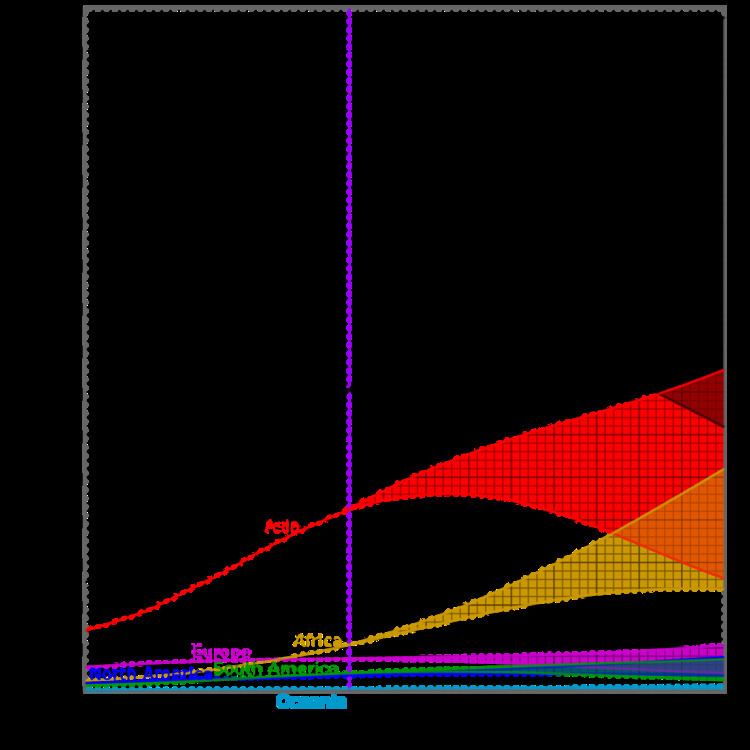 | ||
An arbitrarily selected baby born in a region on the date on which an official demographic authority has predicted the population of the region will pass a milestone figure of N may be symbolically recognised as the region's Nth person. At a world population level, the United Nations Population Fund designated five and six billionth babies in 1987 and 1999 respectively; no official baby was selected on the Day of Seven Billion in 2012.
Contents
World population
World population milestones were unnoticed until the 20th century, since there were no reliable data on global population dynamics.
It is estimated that the population of the world reached one billion for the first time in 1804. It would be another 123 years before it reached two billion in 1927, but it took only 33 years to rise by another billion people, reaching three billion in 1960. Thereafter, the global population reached four billion in 1974, five billion in 1987, six billion in 1999 and, by some estimates, seven billion in October 2011 with other estimates being in March 2012. It is projected to reach eight billion by 2024–2030. According to current projections, the world's population is likely to reach around nine billion by 2045–2050, with alternative scenarios ranging from a low of 7.4 billion to a high of more than 10.6 billion. Projected figures vary depending on underlying statistical assumptions and which variables are manipulated in projection calculations, especially the fertility variable. Long-range predictions to 2150 range from a population decline to 3.2 billion in the 'low scenario', to 'high scenarios' of 24.8 billion. One scenario predicts a massive increase to 256 billion by 2150, assuming fertility remains at 1995 levels.
Five billion
The Day of Five Billion, 11 July 1987, was designated by the United Nations Population Fund as the approximate day on which world population reached five billion. Matej Gašpar from Zagreb, Croatia (then SR Croatia, SFR Yugoslavia), was chosen as the symbolic 5-billionth person concurrently alive on Earth. The honor went to Zagreb because the 1987 Summer Universiade was taking place in the city at the time.
Six billion
The United Nations Population Fund designated 12 October 1999 as the approximate day on which the world population reached six billion. It was officially designated The Day of Six Billion. Demographers do not universally accept this date as being exact. In fact there has been subsequent research which places the day of six billion nearer to 18 June or 19 June 1999. The International Programs division of the United States Census Bureau estimated that the world population reached six billion on 21 April 1999. United Nations Population Fund spokesman Omar Gharzeddine disputed the date of the Day of Six Billion by stating, "The U.N. marked the '6 billionth' [person] in 1999, and then a couple of years later the Population Division itself reassessed its calculations and said, actually, no, it was in 1998."
On the Day of Six Billion, UN Secretary-General Kofi Annan was in Sarajevo, Bosnia and Herzegovina to monitor the Dayton Agreement. At midnight he went to Koševo Hospital, where Adnan Nević, born at 12.01 am, was named the symbolic 6 billionth concurrently alive person on Earth. He is the first son of Fatima Nević and Jasminko Helać and weighed 3.5 kg.
Seven billion
The "Day of Seven Billion" was targeted by the United States Census Bureau to be in March 2012, while the Population Division of the United Nations suggested 31 October 2011, and the latter date was officially designated by the United Nations Population Fund (UNFPA) as the approximate day on which the world's population reached seven billion people. United Nations Secretary General Ban Ki-moon spoke at the United Nations building in New York City on this milestone in the size of world population, and promoted the website 7 Billion Actions. Ban Ki-moon did not choose a symbolic seven billionth baby, but several groups proposed candidates: Nargis Kumar of Uttar Pradesh, India, Danica May Camacho of Manila, Philippines and Wattalage Muthumai of Colombo, Sri Lanka.
National and regional population
National or subnational governments have sometimes made similar designations based on the date estimated by a demographic agency. Some national milestones relate to citizens rather than residents. Commentators in countries with high immigration have pointed out that a population milestone may be reached by an immigrant rather than natural increase.
